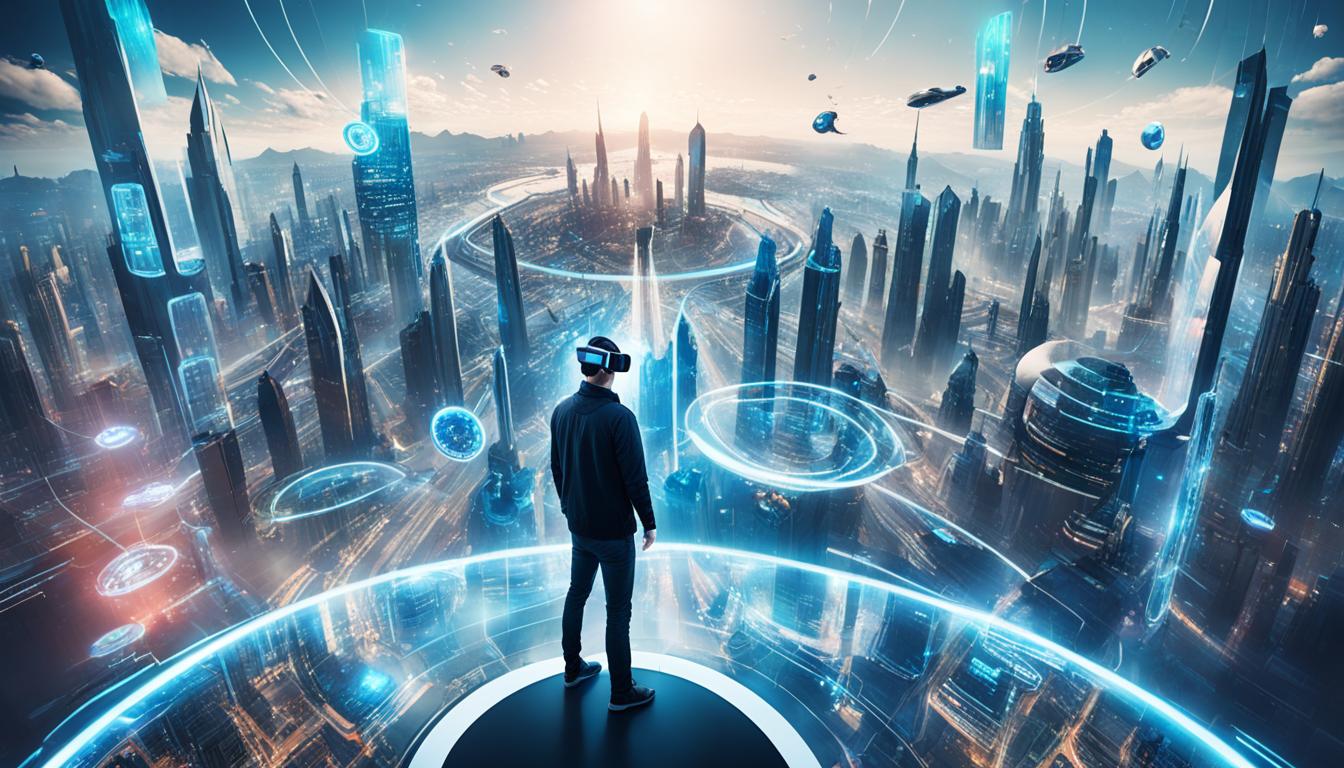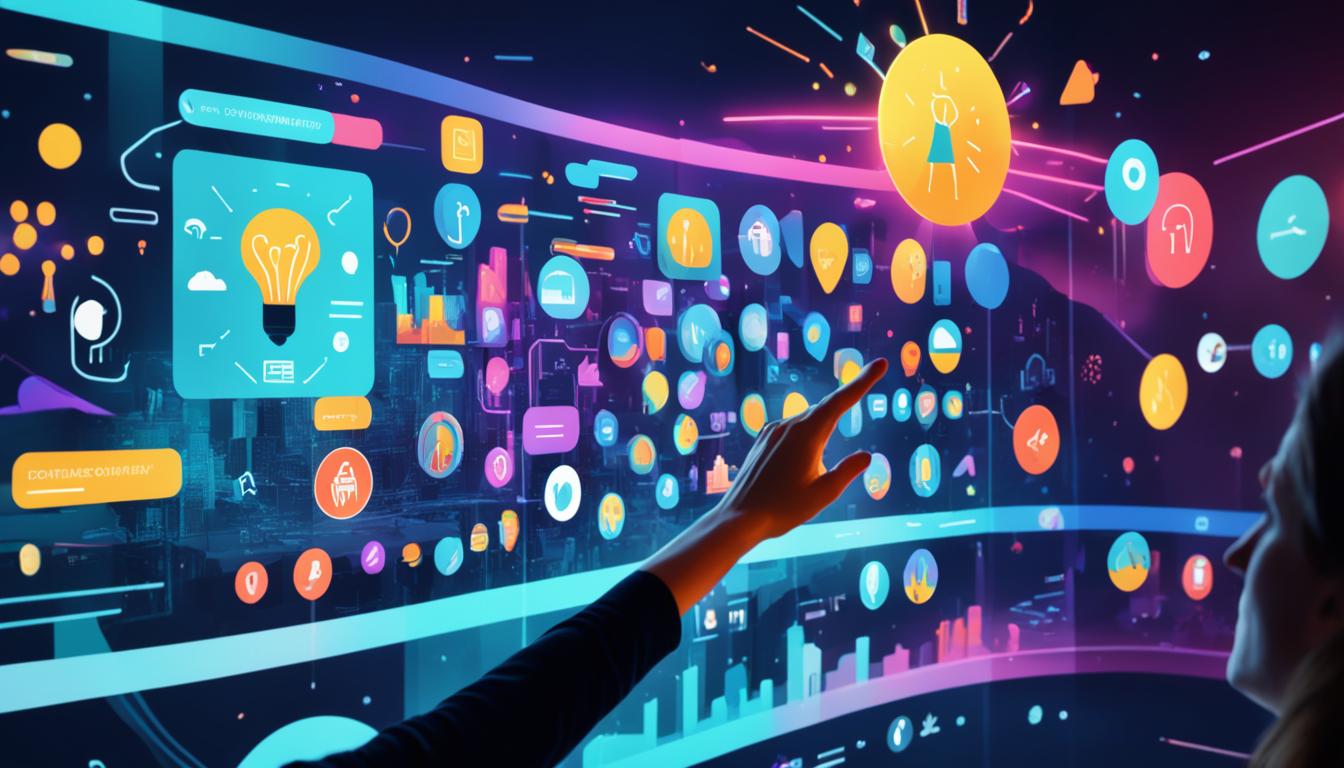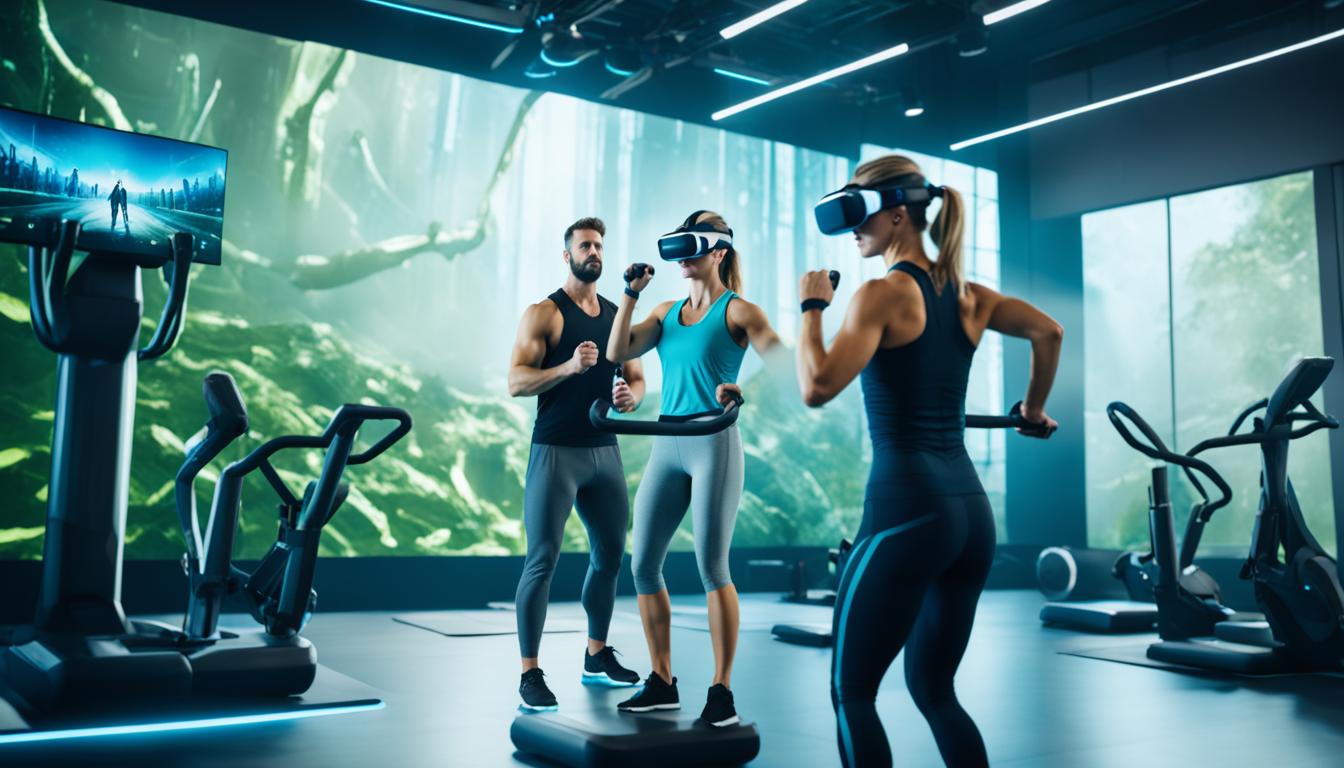Virtual reality (VR) has taken the world by storm, offering immersive experiences that go beyond the realm of gaming. But did you know that VR has applications in healthcare, education, art, and even remote collaboration? The possibilities are endless. So, what are the non-gaming uses of virtual reality? How is this technology transforming various industries? Let’s dive into the diverse world of virtual reality and discover its potential beyond gaming.
Key Takeaways:
- Virtual reality technology is not limited to gaming but is being increasingly used in various fields.
- VR is revolutionizing healthcare by providing immersive experiences for pain management, therapy, and training.
- Education and training have been transformed through VR, offering immersive learning experiences and realistic simulations.
- Artists are exploring new creative possibilities in VR, using it as a canvas for their imagination.
- VR tools for remote collaboration are bridging the gap between physical and virtual interactions in the workplace.
The Evolution of Virtual Reality
Virtual reality (VR) technology has a rich and fascinating history that dates back to the 1960s. The concept of VR was first introduced with the creation of the first head-mounted display. However, it wasn’t until the 1990s that VR began to gain mainstream attention with the release of consumer devices like the Virtual Boy.
Over the years, there has been a significant evolution in VR devices, making them more accessible and affordable for the general public. One notable example is the Oculus Quest 2, which was released in 2020. The Oculus Quest 2 offers a wireless and standalone VR experience, eliminating the need for external sensors or a gaming PC. This level of accessibility has played a crucial role in driving the adoption of VR by a wider audience.
The advancements in VR technology have also led to its integration into various industries beyond gaming. From healthcare to education, VR has found its way into diverse fields, offering unique and immersive experiences. This widespread adoption of VR showcases its potential as a transformative tool for numerous applications.
To better understand the evolution of virtual reality, let’s take a closer look at the timeline of VR devices and their impact on the accessibility and adoption of VR:
| Decade | Milestone |
|---|---|
| 1960s | Introduction of the first head-mounted display. |
| 1990s | Release of consumer devices like the Virtual Boy. |
| 2020 | Launch of the Oculus Quest 2, a more accessible and affordable VR device. |
As we can see from the timeline, VR has come a long way since its inception. The advancements in VR technology coupled with the increased accessibility and affordability of VR devices have paved the way for its widespread adoption and integration into various industries.
Through the evolution of virtual reality, we can witness the incredible impact it has had on our lives and the endless possibilities it holds for the future.
Virtual Reality in Healthcare
Virtual reality (VR) has emerged as a powerful tool in the field of healthcare, revolutionizing patient care and medical training. From pain management to rehabilitation, VR has found valuable applications in various aspects of healthcare.
Pain Management with VR
One of the significant benefits of VR in healthcare is its ability to alleviate pain and discomfort. By immersing patients in virtual environments, VR therapy offers a distraction from physical sensations. Research has shown that VR can reduce pain perception during procedures, making it a promising alternative to traditional pain management methods.
Enhancing Therapy and Rehabilitation
VR is increasingly being used in physical therapy and cognitive rehabilitation. By creating immersive environments, VR therapy facilitates the recovery process by providing interactive and engaging exercises. Patients can perform therapeutic tasks in virtual settings, encouraging movement and cognitive stimulation.
Virtual Surgeries and Training
Virtual reality enables medical students and healthcare professionals to practice surgeries in a safe and controlled environment. Through VR simulations, surgeons can refine their skills and techniques before operating on real patients. This virtual practice enhances precision and reduces the likelihood of errors during actual surgeries, ultimately improving patient outcomes.
Applications in Healthcare
Virtual reality has a wide range of applications in healthcare, extending beyond pain management and surgeries. Some of the key areas where VR is making a significant impact include:
- Mental Health: VR therapy is being used to treat phobias, anxiety disorders, and post-traumatic stress disorder (PTSD).
- Rehabilitation: VR is employed in physical rehabilitation programs to enhance motivation and accelerate recovery.
- Medical Education: VR simulations aid in training medical students, allowing them to practice complex procedures in virtual environments.
- Remote Care: VR enables remote consultations and telemedicine, bringing healthcare services to underserved areas.
Incorporating virtual reality technology into healthcare not only improves patient outcomes but also enhances the efficiency and effectiveness of medical interventions. VR continues to push the boundaries of medical innovation, offering new possibilities for patient care and medical advancements.
Virtual Reality in Education and Training
Virtual reality (VR) has revolutionized education and training, offering immersive learning experiences that go beyond traditional methods. Students can now explore historical events, dive into scientific concepts, and participate in realistic simulations, enhancing their understanding and retention. VR has opened up new possibilities for education, enabling students to engage with subjects in a truly immersive way.
One of the key advantages of VR in education is the ability to create virtual simulations. Medical students, for example, can use VR to practice complex procedures in a safe and controlled environment. They can perform virtual surgeries, gaining valuable experience before entering the operating room. This hands-on training enhances their skills and confidence, leading to better patient outcomes.
Aviation trainees also benefit from VR technology. They can simulate emergency landings and practice critical decision-making in high-pressure situations. By experiencing these scenarios virtually, pilots gain valuable experience without any risk to themselves or the aircraft. VR training in aviation ensures that pilots are well-prepared to handle real-life emergencies, ensuring the safety of passengers and crew.
Architects and designers have also embraced VR for its ability to create immersive walkthroughs of buildings and landscapes. Clients can now step into a virtual environment and experience designs in a 3D space before construction even begins. This allows for detailed collaboration and ensures that the final product meets the client’s expectations. VR has transformed the way architectural projects are presented and experienced.
Advantages of Virtual Reality in Education and Training:
- Enhanced learning experiences through immersion and interactivity
- Safe and realistic simulations for hands-on training
- Increased engagement and retention of knowledge
- Opportunities for experiential learning and exploration
- Improved collaboration and communication among students and educators
“VR technology has revolutionized education and training by providing students with immersive learning experiences and realistic simulations. Medical students can now practice procedures, aviation trainees can simulate emergency landings, and architects can create immersive walkthroughs of their designs. VR has opened up new possibilities for experiential learning and enhanced collaboration.”
| Industry | VR Application |
|---|---|
| Education | Exploring historical events and scientific concepts |
| Medical | Practicing procedures and surgeries |
| Aviation | Simulating emergency landings and critical decision-making |
| Architecture | Creating immersive walkthroughs of designs |
Virtual Reality in Art and Creativity
Virtual reality (VR) is not just limited to gaming; it is also transforming the world of art and creativity. Artists are embracing the immersive capabilities of VR technology and using it as a canvas to push the boundaries of traditional artistic expression. One tool that has revolutionized VR art is Tilt Brush.
Tilt Brush allows artists to paint in three dimensions, creating stunning and interactive artworks that come to life in the virtual realm. With Tilt Brush, artists have the freedom to explore new forms of artistic expression, unrestricted by physical limitations. They can paint with light, sculpt with sound, and even collaborate with other artists in virtual spaces.
Artistic Expression Beyond Reality
Virtual reality offers new possibilities for artistic expression by blurring the lines between the physical and digital worlds. Artists can manipulate the environment, experiment with unconventional materials, and create interactive experiences that engage and captivate viewers. By immersing themselves and their audience in virtual worlds, artists can evoke emotions and tell stories in innovative and impactful ways.
“Virtual reality allows artists to step outside the traditional canvas and embark on a journey of limitless creativity. It’s like entering a whole new dimension where imagination knows no bounds.” – Emily Thompson, VR artist
The Future of Virtual Reality Art
The use of virtual reality in art is still in its early stages, but the potential for growth and innovation is immense. As VR technology continues to advance, we can expect to see even more groundbreaking artistic creations and collaborations. Artists will have access to increasingly sophisticated tools and platforms, empowering them to explore uncharted territories and reshape the art landscape.
VR Art Examples
| Artwork | Artist | Description |
|---|---|---|
| Anna Johnson | A mesmerizing VR painting that combines vibrant colors and fluid motions, allowing viewers to step into a world of imagination. | |
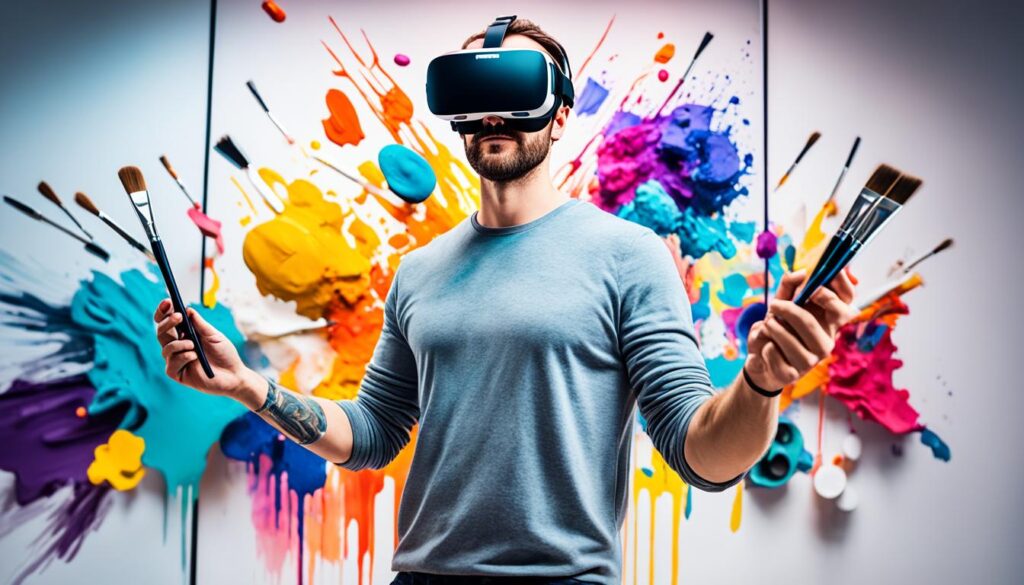 |
Michael Rodriguez | An immersive VR experience where participants can interact with digital sculptures and explore the artist’s vision of a dystopian future. |
| Sarah Collins | A collaborative VR artwork created using Tilt Brush, featuring multiple artists contributing their unique styles and perspectives. |
Virtual reality is revolutionizing art by providing artists with a new medium for self-expression and creativity. As the technology continues to evolve, artists will have even more tools and possibilities at their fingertips. VR is expanding the boundaries of art and inviting us into a world of immersive experiences that challenge our perceptions and inspire our imaginations.
Virtual Reality for Remote Collaboration
With the rise of remote work, virtual reality (VR) has emerged as a game-changing technology for facilitating seamless collaboration among teams. VR tools such as Spatial are gaining popularity as they enable professionals to work together in virtual meeting spaces, transcending the limitations of physical distance.
Using VR collaboration tools, remote teams can come together in a shared virtual environment that simulates a real meeting room. This immersive experience creates a sense of presence, making it feel as if all participants are in the same room, regardless of their actual locations. The ability to see and interact with avatars of team members fosters creativity, enhances communication, and strengthens the connection among colleagues, ultimately driving productivity and innovation.
One of the key advantages of VR for remote work is the ability to visualize and manipulate 3D models or data in real-time. Whether it’s brainstorming ideas, reviewing architectural designs, or analyzing complex datasets, VR collaboration tools provide a compelling and interactive environment where participants can engage with information in a more intuitive and dynamic way.
Benefits of VR for Remote Collaboration:
- Enhanced collaboration and communication among remote teams.
- Increased engagement and creativity in virtual meeting spaces.
- Improved visualization and manipulation of 3D models or data.
- Facilitation of virtual presentations and immersive training sessions.
- Cost and time savings by eliminating the need for physical travel.
Moreover, VR for remote collaboration offers a more inclusive and equitable work environment by breaking down geographical barriers. It enables employees from different locations to actively participate in meetings, presentations, and discussions, fostering a sense of belonging and inclusion within the team.
As the world continues to embrace remote work, the demand for VR collaboration tools is expected to grow. The potential applications of VR in remote collaboration extend beyond traditional office settings to various industries, including architecture, design, engineering, and education.
In the words of Mark Zuckerberg, CEO of Meta Platforms, Inc. (formerly Facebook), “Virtual reality is going to be the most social platform.” The future of remote collaboration lies in the immersive and interconnected world of VR.
Virtual reality is revolutionizing the way we collaborate remotely, providing a glimpse into a future where physical proximity is no longer a limitation. As the technology continues to advance and become more accessible, businesses and individuals alike can harness the power of VR to overcome geographical boundaries, promote innovation, and unlock new possibilities in remote work.
Virtual Meeting Spaces – A Game-Changing VR Collaboration Tool
One of the notable VR collaboration tools in the market is Spatial. This platform offers virtual meeting spaces where users can meet, collaborate, and share content in a virtual environment. Spatial’s intuitive interface and interactive features make it easy for teams to work together seamlessly, whether they are brainstorming, reviewing projects, or conducting presentations.
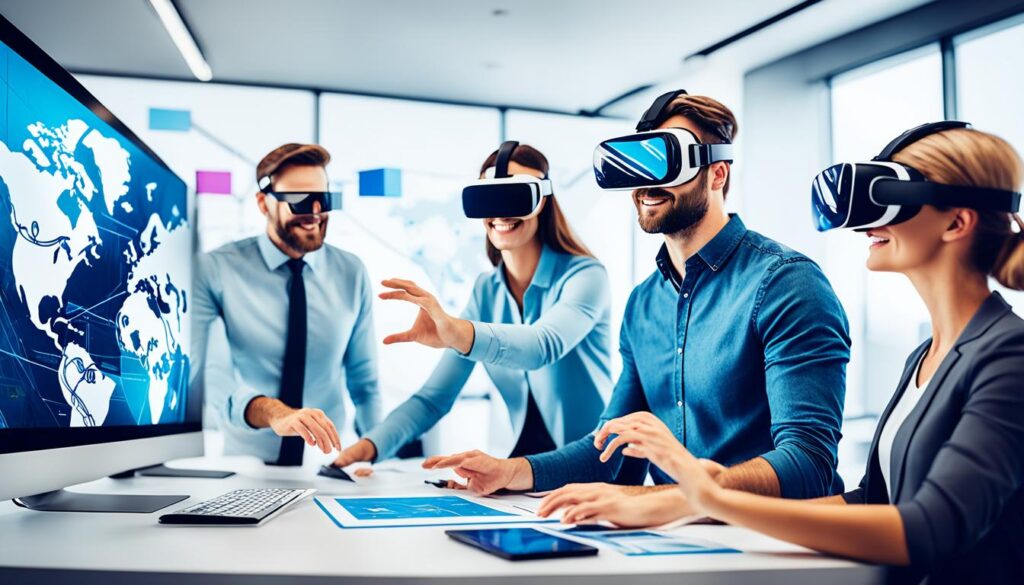
With Spatial, participants can create and customize their avatars, allowing for a personalized and engaging virtual experience. The platform supports various file formats, enabling users to import and manipulate 3D models, documents, images, and more. Spatial’s virtual meeting spaces offer real-time collaboration tools, such as whiteboards and spatial audio, to enhance interactivity and productivity.
By leveraging the power of VR, Spatial and other similar platforms are reshaping the landscape of remote collaboration, providing a virtual workspace where teams can come together, regardless of their physical locations.
| Benefits of VR for Remote Collaboration | Examples |
|---|---|
| Enhanced collaboration and communication | Virtual brainstorming sessions |
| Increased engagement and creativity | Virtual design reviews |
| Improved visualization and manipulation of 3D models or data | Virtual architectural walkthroughs |
| Facilitation of virtual presentations and immersive training sessions | Virtual product demos |
| Cost and time savings | Elimination of physical travel |
Virtual Reality Industry Insights
The virtual reality industry is constantly evolving, driven by new trends and emerging challenges. While virtual reality (VR) has made significant progress, it still confronts obstacles such as motion sickness, high costs, and the demand for powerful hardware. However, as technology continues to advance and become more accessible, the future of VR looks promising.
One of the key players in the virtual reality industry is Meta Platforms, Inc., formerly known as Facebook. Meta Platforms has positioned itself as a pioneer in the VR and augmented reality (AR) space, propelling the development of the metaverse—a digital universe where users can interact with one another and the environment in immersive ways.
Virtual Reality Trends
- Increased adoption in sectors such as healthcare, education, and architecture
- VR integration with other technologies, such as AI and blockchain
- Expansion of social VR platforms and virtual meeting spaces
- Rise of standalone VR devices for easier accessibility
- Exploration of VR for entertainment beyond gaming, such as immersive storytelling
VR Challenges
- Motion sickness: Addressing the discomfort experienced by some users when using VR
- Cost: Making VR more affordable for wider adoption
- Hardware requirements: Ensuring VR experiences are compatible with a range of devices
- Content creation and availability: Expanding the library of VR experiences and applications
- Privacy and ethical concerns: Safeguarding user data and ensuring responsible use of VR technology
Despite these challenges, the potential of virtual reality in various industries cannot be ignored. As the technology matures and becomes more user-friendly, it has the power to revolutionize healthcare, education, art, and more. The key lies in overcoming obstacles and harnessing the true potential of VR.
Virtual Reality Hardware
One of the essential components for a quality VR experience is reliable and technologically advanced hardware. VR hardware includes headsets, controllers, haptic feedback devices, and sensors. Advanced headsets like the Oculus Rift and HTC Vive offer immersive visuals and precise tracking, while VR controllers provide users with interactive and realistic experiences.
The demand for more powerful VR hardware continues to grow as developers push the boundaries of virtual reality experiences. Companies are investing in research and development to create devices that are more comfortable, affordable, and capable of delivering truly immersive VR environments.
Meta Platforms CEO, Mark Zuckerberg, stated, “We believe that the next chapter for our company is to bring the metaverse to life,” emphasizing the company’s commitment to shaping the future of VR and AR technology.
The ongoing advancements in virtual reality hardware will enable users to delve deeper into the virtual realms, unlocking new possibilities for innovative applications and experiences.
Conclusion
The impact of virtual reality (VR) extends far beyond the realm of gaming. Its potential to transform industries and offer new ways of experiencing the world is boundless. As technology continues to advance and VR becomes more widely adopted, the future of virtual reality holds incredible possibilities.
From healthcare to education, architecture to art, VR is revolutionizing diverse fields. In healthcare, VR is being used for pain management, therapy, and even virtual surgeries, enhancing patient care and medical training. In education, VR provides immersive learning experiences that allow students to explore historical events, scientific concepts, and participate in realistic simulations. Artists are using VR as a canvas for their creativity, pushing the boundaries of traditional artistic expression.
As we move forward, it is crucial to harness the potential of VR responsibly and ethically, ensuring its positive impact on society. The possibilities offered by virtual reality are limited only by our imagination. With ongoing innovation and advancements in technology, the virtual reality landscape is set to expand even further, providing new and exciting opportunities for immersive experiences and creative applications.
The future of virtual reality is bright, offering a world where we can step into new realities, interact with digital environments, and connect with others in ways previously unimaginable. As we embrace the potential of VR, let us strive for a future where technology enriches our lives and empowers us to create a better, more immersive world.
